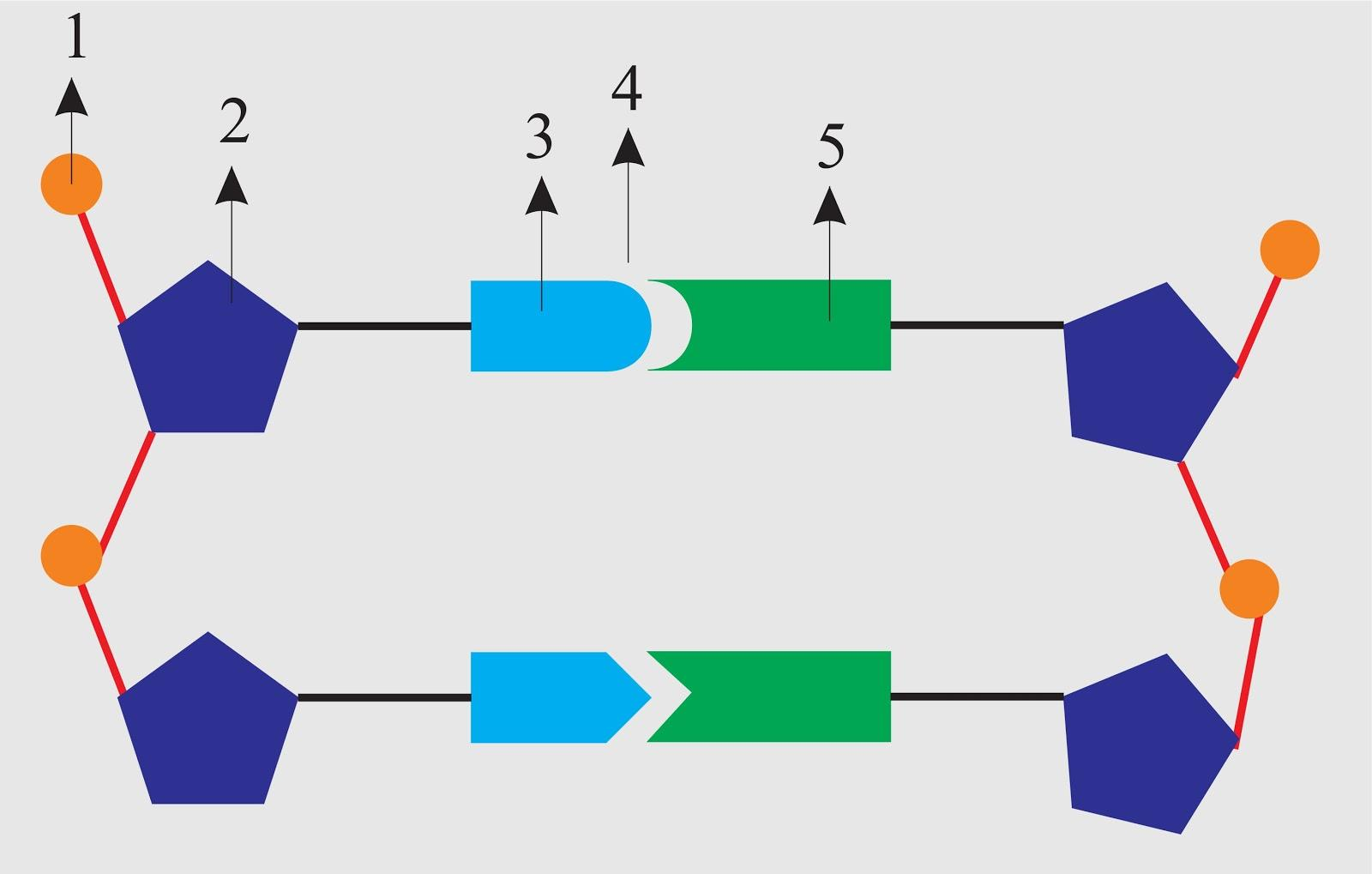
Given below is a schematic diagram of a portion of DNA.
(a) How many strands are shown in the diagram?
(b) How many nucleotides have been shown in each strand?
(C) Name the parts numbered 1,2,3,4 and 5 respectively
(d) Name the DNA unit constituted by the parts 1,2 and 3 collectively.


Answer
527.4k+ views
Hint: A DNA is a double-stranded structure where each strand is a long chain of polymers arranged end to end. Each polymer is further made up of three subunits. The two strands are held together by a special type of bond which is also responsible for the high boiling point of water.
Complete answer:
The two strands are arranged antiparallel to each other. Each molecule of nucleotide contains a phosphate group, deoxyribose sugar, and a nitrogen base. The four types of nitrogen bases of nucleotides are adenine (A), thymine (T), guanine (G), and cytosine(C) where adenine and guanine are purines and thymine and cytosine are pyrimidines.
-In the given picture, there are two polynucleotide chains.
-There is a total of 4 nucleotides in the picture with two nucleotides in each strand.
-The part numbered 1 is a phosphate group. The part numbered 2 is deoxyribose sugar. The part numbered 3 is a pyrimidine which is bonded to part number 5 which is a purine. They both are bonded via hydrogen bonds which are represented by part number 4.
-The DNA unit constituted by parts 1,2, and 3 are collectively known as a nucleotide.
-The phosphate group is bonded to sugar via a 5’-phospho-ester linkage. They form the backbone of the DNA molecule. The nitrogenous bases are linked to 1’ carbon of deoxyribose sugar via glycosidic bonds.
-Two polynucleotides are linked through 3’-5’ phosphodiester linkage to form a dinucleotide and when many nucleotides are joined in this fashion, then a polynucleotide is formed.
-The two polynucleotide chains coil over one another via hydrogen bonding to create a structure called a double helix.
- The bases on one strand pair with the bases on another strand based on complementarity rules of base pairing.
Note:
-The structure of DNA was proposed by Francis Crick and James Watson in 1953.
-The two strands have an antiparallel polarity i.e. one chain has a 5’ to 3’ polarity while the other strand has a 3’ to 5’ polarity.
-In the base-pairing rule, adenine on one strand pairs with the thymine of another strand, and similarly the guanine of one strand pairs with the cytosine of the other strand.
Complete answer:
The two strands are arranged antiparallel to each other. Each molecule of nucleotide contains a phosphate group, deoxyribose sugar, and a nitrogen base. The four types of nitrogen bases of nucleotides are adenine (A), thymine (T), guanine (G), and cytosine(C) where adenine and guanine are purines and thymine and cytosine are pyrimidines.
-In the given picture, there are two polynucleotide chains.
-There is a total of 4 nucleotides in the picture with two nucleotides in each strand.
-The part numbered 1 is a phosphate group. The part numbered 2 is deoxyribose sugar. The part numbered 3 is a pyrimidine which is bonded to part number 5 which is a purine. They both are bonded via hydrogen bonds which are represented by part number 4.
-The DNA unit constituted by parts 1,2, and 3 are collectively known as a nucleotide.
-The phosphate group is bonded to sugar via a 5’-phospho-ester linkage. They form the backbone of the DNA molecule. The nitrogenous bases are linked to 1’ carbon of deoxyribose sugar via glycosidic bonds.
-Two polynucleotides are linked through 3’-5’ phosphodiester linkage to form a dinucleotide and when many nucleotides are joined in this fashion, then a polynucleotide is formed.
-The two polynucleotide chains coil over one another via hydrogen bonding to create a structure called a double helix.
- The bases on one strand pair with the bases on another strand based on complementarity rules of base pairing.
Note:
-The structure of DNA was proposed by Francis Crick and James Watson in 1953.
-The two strands have an antiparallel polarity i.e. one chain has a 5’ to 3’ polarity while the other strand has a 3’ to 5’ polarity.
-In the base-pairing rule, adenine on one strand pairs with the thymine of another strand, and similarly the guanine of one strand pairs with the cytosine of the other strand.
Recently Updated Pages
Master Class 12 English: Engaging Questions & Answers for Success

Master Class 12 Business Studies: Engaging Questions & Answers for Success

Master Class 12 Economics: Engaging Questions & Answers for Success

Master Class 12 Social Science: Engaging Questions & Answers for Success

Master Class 12 Maths: Engaging Questions & Answers for Success

Master Class 12 Chemistry: Engaging Questions & Answers for Success

Trending doubts
What are the major means of transport Explain each class 12 social science CBSE

Which are the Top 10 Largest Countries of the World?

Draw a labelled sketch of the human eye class 12 physics CBSE

Explain sex determination in humans with line diag class 12 biology CBSE

The pH of the pancreatic juice is A 64 B 86 C 120 D class 12 biology CBSE

Explain sex determination in humans with the help of class 12 biology CBSE




